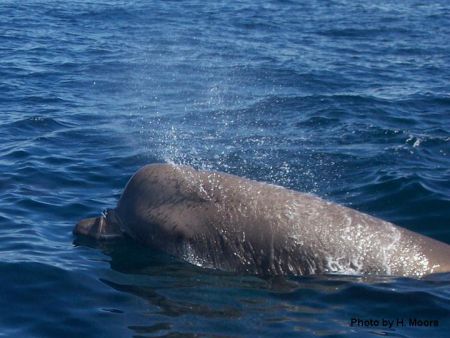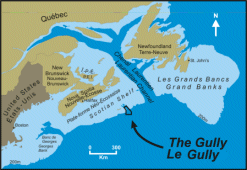K'JIPUKTUK, HALIFAX - Scientists fear that a recently issued call for bids for offshore oil and gas exploration is too close to the critical habitat of the endangered northern bottlenose whale.
The call for bids encompasses areas directly adjacent to the Sable Gully, a world renowned Marine Protected Area, and also includes parts of the adjacent Shortland and Haldimand canyons 200 kilometres off the coast of Nova Scotia.
"In this particular call for bids, we are near very sensitive areas and around very sensitive species," says Tonya Wimmer, a Halifax-based marine biologist and Species Conservation Manager with the World Wildlife Fund Canada.
The Sable Gully and the two canyons are the year-round habitat of an endangered population of about 200 bottlenose whales. A wide variety of dolphins, leatherback turtles and orca also pass through the area, as do blue whales, sperm whales and Sowerby's beaked whales.
Wimmer is worried about the effects on marine wildlife when blasts of compressed air are fired in rapid succession by airguns positioned on up to five ships traveling in formation – not just once in a while, but for days on end.
These blasts generate seismic waves which allow scientists to map the geological strata below the ocean floor. Such seismic testing is part of all early stages of offshore oil and gas exploration.
It gets very noisy, says Wimmer, who spent time doing research in the area between 2000 and 2002.
"There were people in the middle of the Atlantic, and the seismic activities off our coast would be the dominant noise they would hear."
"For these whales the environment is really an acoustic one," says Wimmer. "They can see fine, but sound input determines how they find their mates in the community, how they find their food at the great depths that they dive to."
"I always compare it with somebody flashing a bright light into your face. How would you know not to walk into traffic, how would you know not to fall off a cliff," she adds.
The Canada Nova Scotia Offshore Petroleum Board (CNSOPB) issued the call for bids.
The CNSOPB, a joint venture of the federal government and the province, manages Nova Scotia's offshore oil and gas resources. It solicits proposals and issues licenses for offshore oil and gas activities. Both rig workers' safety and protecting the ocean are within the mandate of the CNSOPB.
In 2012 BP Exploration Canada paid $1-billion for the right to search for oil in an adjacent parcel. Shell Canada also is active in the Nova Scotia offshore.
In an email dated May 15, CNSOPB spokesperson Kathleen Funke explains that a successful bidder is required to submit an environmental assessment, including measures to protect the bottlenose whale and other ocean wildlife from harm.
"These measures would include having Marine Mammal Observers on board as well as Fisheries Liaison Officers, stopping the engines if marine mammals are spotted within a certain radius, avoiding certain areas during known migration, etc.," writes Funke.
In a follow-up email, Funke states that just because the canyons are included in the call for bids does not mean they will necessarily become subject to seismic testing. That remains to be determined, she writes.
Lindy Weilgart, a Dalhousie University research associate in Biology, has studied the effects of seismic testing on marine wildlife since she was a postdoctoral fellow at Cornell University.
Whether the canyons are included or not, they are too close, Weilgart says. Sound travels.
Weilgart does not think the measures suggested by the CNSOPB will be effective. For instance, avoiding the area during migration will not work because the bottlenose whale is a year-round resident.
Although the presence of observers on the ships is better than nothing, Weilgart argues, they are likely to miss most of the whales present because of fog, stormy weather and seismic activities at night.
"There are new studies about blue whales, who are very visible, they have that high vertical blow and they're the world's largest animals, even those sightings plummet when there is even a slight breeze," Weilgart warns.
"Sightings for bottlenose whales are going to be way worse than that," Weilgart says. "The best estimates are that you will see two per cent – the ones right in front of you."
Wimmer believes that we simply don't know enough about the effects of seismic testing on marine wildlife, and that therefore we should err on the side of caution.
"Studies on impact on whales from loud sound sources are mostly inconclusive in the sense that there are animals that respond kilometers away [from the sound source] and others that don't respond when the sound is right next to them," says Wimmer.
"But even if they don't respond, that doesn't mean that it doesn't impact them. Maybe the area is so important that they can't leave."
Wimmer adds that scientists have yet to determine the safe distance between seismic activity and marine wildlife habitat. "The precautionary principle is something that guides how as a government you are supposed to behave when you don't have all the info," she says.
"The idea of putting the call for bids right on to on top of the canyons and right nest to the Sable Gully protected area is counter-intuitive and not precautionary.
See also
Newfoundland Petroleum Board gives go ahead to oil and gas exploration in Gulf of St. Lawrence
Hunt for oil in the Gulf of St. Lawrence intensifies
Drilling for oil off the coast of Nova Scotia
Offshore seismic testing puts wildlife at risk, biologist fears
Follow Robert Devet on Twitter @DevetRobert




